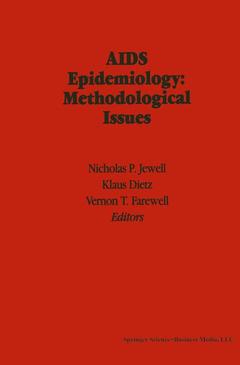AIDS Epidemiology, Softcover reprint of the original 1st ed. 1992 Methodological Issues
Langue : Anglais
Coordonnateurs : Jewell Nicholas P., Dietz Klaus, Farewell Vernon T.

In 1974, the Societal Institute of the Mathematical Sciences (SIMS) initiated a series of five-day Research Application Conferences (RAC's) at Alta, Utah, for the purpose of probing in depth societal fields in light of their receptivity to mathematical and statistical analysis. The first eleven conferences addressed ecosystems, epidemiology, energy, environmental health, time series and ecological processes, energy and health, energy conversion and fluid mechanics, environmental epidemiology: risk assessment, atomic bomb survival data: utilization and analysis, modem statistical methods in chronic disease epidemiology and scientific issues in quantitative cancer risk assess ment. These Proceedings are a result of the twelfth conference on Statistical Methodology for Study of the AIDS Epidemic which was held in 1991 at the Mathematical Sciences Research Institute, Berkeley, California. For five days, 45 speakers and observers contributed their expertise in the relevant biology and statistics. The presentations were timely and the discussion was both enlightening and at times spirited. Members of the Program Committee for the Conference were Klaus Dietz (University of Tiibingen, Germany), Vernon T. Farewell (University of Waterloo, Ontario), and Nicholas P. Jewell (University of California, Berke ley) (Chair). The Conference was supported by a grant to SIMS from the National Institute of Drug Abuse. D. L. Thomsen, Jr.
Section 1. The Backcalculation Technique for Reconstruction of HIV Infection Patterns and AIDS Projections.- Perspectives on Using Backcalculation to Estimate HIV Prevalence and Project AIDS Incidence.- Statistical Methods for Reconstructing Infection Curves.- Uncertainty About the Incubation Period of AIDS and Its Impact on Backcalculation.- A Comprehensive Back-Calculation Framework for the Estimation and Prediction of AIDS Cases.- Use of Empirical Transformations in Nonparametric Back-projection of AIDS Incidence Data.- The HIV Epidemic in New York City: Statistical Methods for Projecting AIDS Incidence and Prevalence.- Section 2. HIV Transmission Models.- Triangles in Heterosexual HIV Transmission.- Structured Population Models for HIV Infection Pair Formation and Non-constant Infectivity.- Weak Linkage Between HIV Epidemics in Homosexual Men and Intravenous Drug Users in New York City.- Section 3. Statistical Approaches to Markers of HIV Disease Progression.- Marker Models in Survival Analysis and Applications to Issues Associated with AIDS.- Modeling a Marker of Disease Progression and Onset of Disease.- The Relationship of CD4 Counts Over Time to Survival in Patients with AIDS: Is CD4 a Good Surrogate Marker?.- Modeling the Relationship Between Progression of CD4-Lymphocyte Count and Survival Time.- Recovery of Information and Adjustment for Dependent Censoring Using Surrogate Markers.- Section 4. General Methodological Investigations.- Semi-Parametric Estimation of the Incubation Period of AIDS.- Using Semiparametric Risk Sets for the Analysis of Cross-Sectional Duration Data.- Is Earlier Better for AZT Therapy in IIIV Infection? A Mathematical Model.- On the Estimation Problem of Mixing/Pair Formation Matrices with Applications to Models for Sexually-Transmitted Diseases.
Date de parution : 08-2012
Ouvrage de 402 p.
15.5x23.5 cm
Thème d’AIDS Epidemiology :
© 2024 LAVOISIER S.A.S.
